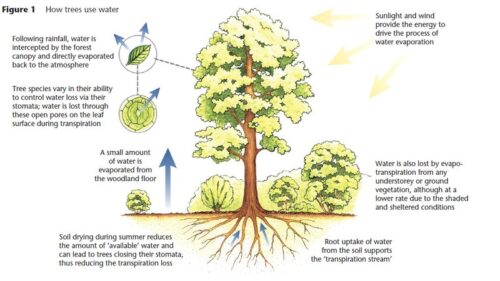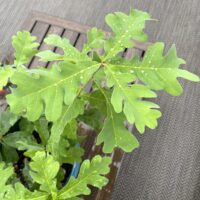 Purdue University - Extension - Forestry and Natural Resources
Purdue University - Extension - Forestry and Natural Resources
Got Nature? Blog
Purdue Landscape Report: Water covers approximately 71% of Earth’s surface, yet only 3% of the 326 million cubic miles of water on the planet is suitable for growing crops, such as trees. It can be said that water is the single most limiting ecological factor in tree growth and survival. It is a vital “nutrient” that must be available in adequate supply or plants decline and eventually die.

How trees use water is essential to determine water needs.
Trees use or lose water by two separate processes. First, water is taken up by tree roots from the soil and evaporated through the pores or stomata on the surface of leaves. Transpiration is a physiological process responding to soil and atmospheric factors. It is a passive movement of water through the tree system which allows columns of water to move great heights. Water movement through a tree is controlled by the tug-of-war between water availability and water movement in soil versus water loss from leaves. For example, water movement in a ring porous tree like a red oak is 92 ft/hr, in a diffuse porous tree like a basswood is 11 ft/hr, and for a pine tree is 6 ft/hr. Trees can absorb between 10 and 150 gallons of water daily, yet of all the water absorbed by plants, less than 5% remains in the plant for growth. They rely on available water in the soil to “rehydrate” during the nighttime hours, replacing the water loss during the daytime hours.
The second process is the interception of water by the surfaces of leaves, branches and trunks during rainfall, and its following evaporation. Together, these two processes are often referred to as evapotranspiration. Both transpiration and evaporation are strongly affected by the amount of sunlight, the temperature and humidity of the air, as well as wind speed as trees turn water into mist when it releases nearly 95% of the water it absorbs.
Just why does a tree need water? Well, nearly every plant process such as photosynthesis, respiration and transpiration rely on water to function properly. Water is an essential element as important if not more than other nutrients because it is required to put all our other elements into a form usable by the plant. Almost all essential elements are ionic forms dissolved in water, giving them the ability to move to stems, branches, and leaves for energy.
The goal of proper tree management is to prevent or reduce the impacts of water loss. If adequate soil moisture is available, water loss will go unnoticed as it is replaced naturally. Typically, we experience prolonged dry periods without rain, resulting in drought. Drought conditions are the result of long periods of time without natural rainfall. During dry conditions, soil moisture content is reduced to the point where tree roots can no longer pull the water molecules from the soil. This results in responses from the plant such as wilting, early fall color, scorching and other symptoms. Anytime there is a week without significant rainfall of at least one inch, most likely trees will need some assistance from us to supply the much-needed water for a healthy tree.
Resources:
Water Your Trees, Purdue Extension-Forestry and Natural Resources (FNR) Got Nature? blog
Summer Tree Care, Purdue Landscape Report
Drought? Don’t Forget the Trees!, The Education Store, Purdue Extension resource center
Extreme Heat, Purdue Extension – IN-PREPared
Drought Information, Indiana Department of Natural Resources
Planting Your Tree Part 1: Choosing Your Tree, Purdue Extension-FNR YouTube Channel
Tree Selection for the “Un-natural” Environment, The Education Store
Tree Pruning Essentials Video, Purdue Extension YouTube Channel
Tree Defect Identification, The Education Store
Surface Root Syndrome, The Education Store
Lindsey Purcell, Chapter Executive Director
Indiana Arborist Association

Recent Posts
- The Summer of Triclopyr – Purdue Landscape Report
Posted: August 21, 2024 in Disease, Forestry, Forests and Street Trees, Invasive Plant Species, Urban Forestry, Wildlife - Flying Into July: Bird Banding Season Begins – MyDNR
Posted: August 6, 2024 in Alert, Forestry, Wildlife - Researchers Study Deer-Vehicle Collision Reduction Method
Posted: July 31, 2024 in Safety, Wildlife - Septorioides Needle Blight of Pine – Purdue Landscape Report
Posted: in Disease, Forestry, Plants, Wildlife - Spotted Lanternflies on the Move! – Purdue Landscape Report
Posted: July 30, 2024 in Forestry, Invasive Animal Species, Invasive Insects, Wildlife, Woodlands - Wild Deer in Chronic Wasting Disease Positive Areas – MyDNR
Posted: July 29, 2024 in Disease, Forestry, Urban Forestry, Wildlife - From Forest to Classroom – 2024 NRTI Class
Posted: July 26, 2024 in Community Development, Forestry, Urban Forestry, Wildlife - Virtual Tour Brings Forest Management for Birds to Life
Posted: July 19, 2024 in Forestry, How To, Publication, Wildlife - Summer Tree Care – Purdue Landscape Report
Posted: July 16, 2024 in Forestry, Forests and Street Trees, How To, Plants, Urban Forestry - DNR State Deer Biologist Shares Population Ecology of Deer-IFWOA Webinar
Posted: July 12, 2024 in Forestry, Wildlife, Woodlands
Archives
Categories
- Alert
- Aquaculture/Fish
- Aquatic/Aquaculture Resources
- Ask the Expert
- Christmas Trees
- Community Development
- Disease
- Drought
- Forestry
- Forests and Street Trees
- Gardening
- Got Nature for Kids
- Great Lakes
- How To
- Invasive Animal Species
- Invasive Insects
- Invasive Plant Species
- Land Use
- Natural Resource Planning
- Nature of Teaching
- Plants
- Podcasts
- Ponds
- Publication
- Safety
- Spiders
- Timber Marketing
- Uncategorized
- Urban Forestry
- Webinar
- Wildlife
- Wood Products/Manufacturing
- Woodland Management Moment
- Woodlands
